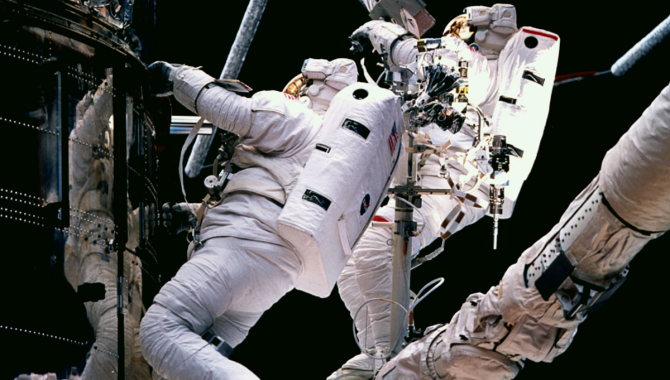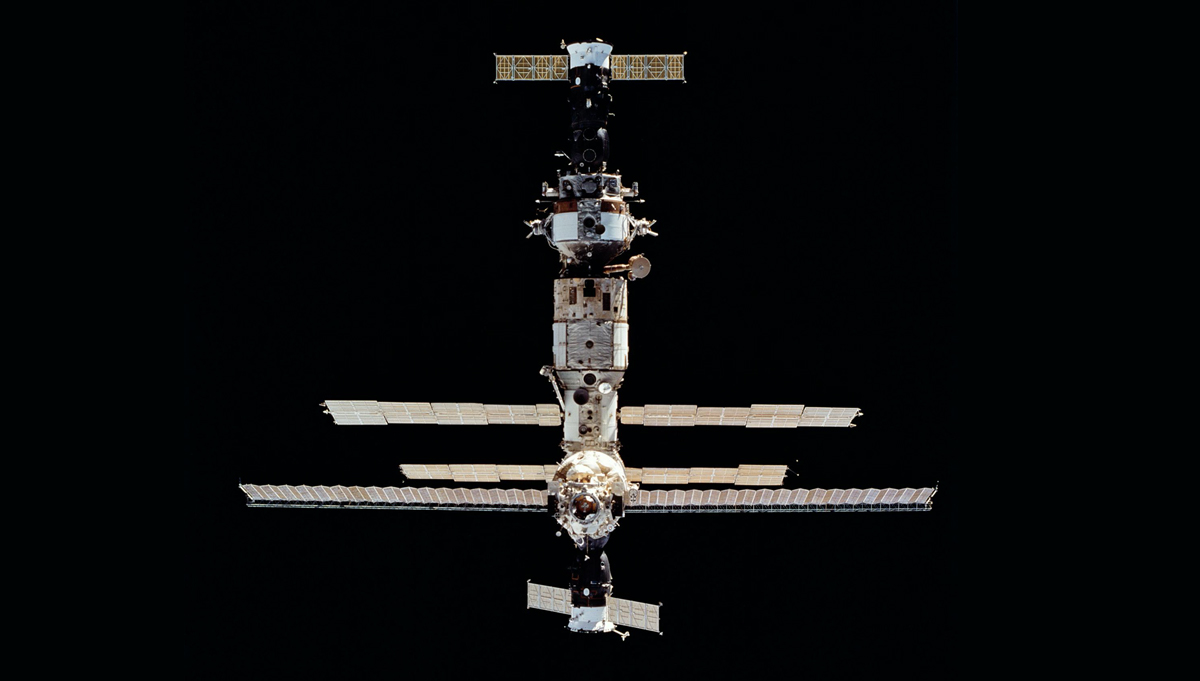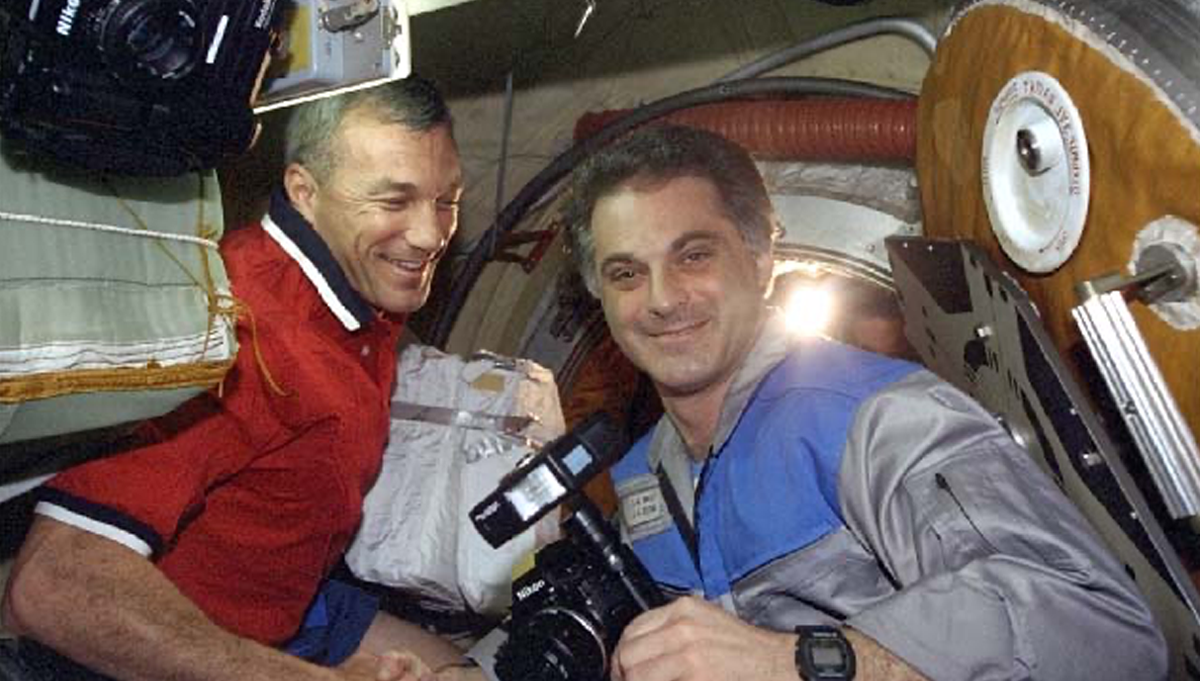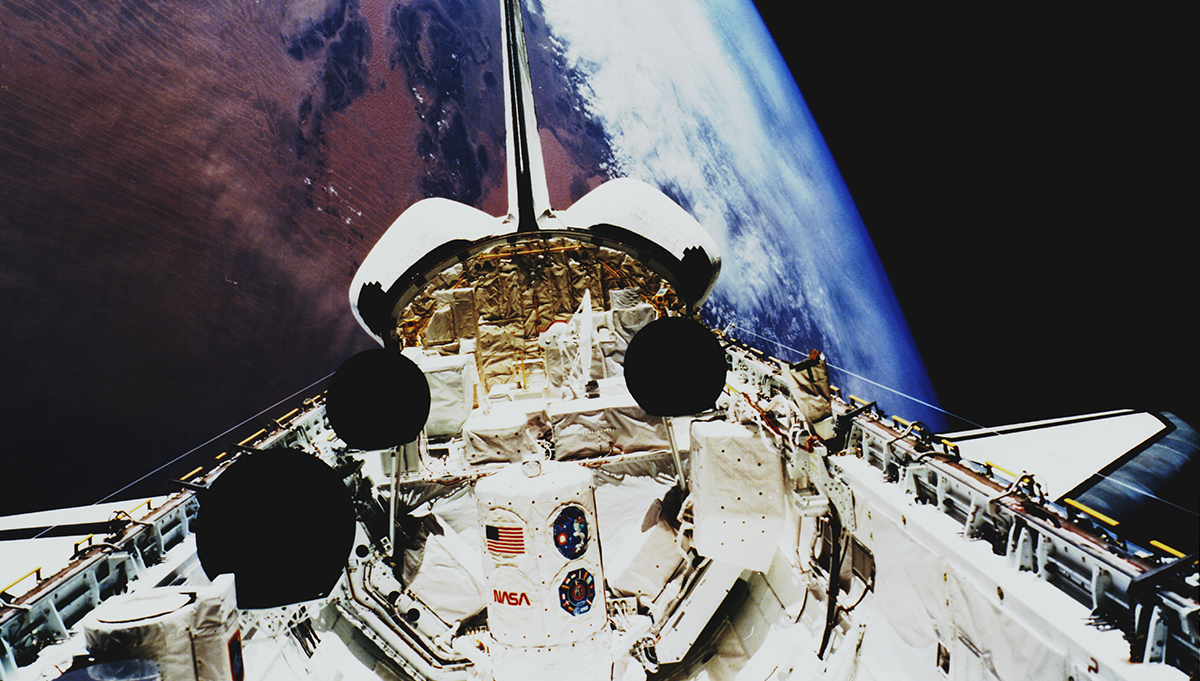
STS-82 crew members Mark C. Lee (left) and Steven L. Smith (on RMS arm) work on the Hubble Space Telescope during the mission’s fifth extravehicular activity (EVA).
Credit: NASA
Hubble servicing mission relies on expertise and experience of seasoned crew.
In the mid-1990s, Steven A. Hawley thought he would never fly in space again. He was a veteran of three shuttle missions by that point, including STS-31, when he operated the Space Shuttle Discovery’s Remote Manipulator System (RMS) to deploy the Hubble Space Telescope for the first time. As Deputy Director of Flight Crew Operations at NASA’s Johnson Space Center, he had decided he would not actively pursue another mission.
“I thought if the circumstances were right and other people thought, ‘Hey, you know, Steve would be the right guy to do this,’ that I would entertain that,” Hawley recalled, in an oral history.
Hawley became an astronaut in 1978. NASA Astronaut Group 8 included pilots with traditional military flight training, and mission specialists, many of whom held advanced degrees in science and would provide the expertise for experiments in low Earth orbit. Hawley holds a Doctorate in Astronomy and Astrophysics.
“When I was a kid, people like me didn’t get to be astronauts, because I didn’t want to be a military test pilot,” Hawley recalled. “NASA did pick civilians in earlier selections. One of the first things they did was send them off to military pilot training and teach them to be jet pilots. … This is the first group where we were accepted as scientists, engineers, doctors, and they didn’t try to make us pilots.”
In 1996, NASA was selecting the crew of STS-82 who would capture the Hubble Space Telescope, perform a series of updates over five complex spacewalks, and redeploy it. The crew needed an experienced robotic arm operator with knowledge of Hubble. Uniquely qualified, Hawley was asked to join the crew and operate the Space Shuttle Discovery’s RMS on the high-profile mission.
Commander Kenneth D. Bowersox was also uniquely qualified for the mission. Bowersox had been the pilot on STS-61, the mission that saved Hubble. Scott J. Horowitz was the Pilot for the veteran crew that included Mission Specialists Mark C. Lee, Gregory J. Harbaugh, Steven L. Smith, and Joseph R. Tanner.
STS-82 launched from Kennedy Space Center on February 11, 1997. The crew had trained extensively for the mission, including time in the Neutral Buoyancy Simulator at NASA’s Marshall Space Flight Center.
“The training was really excellent. This was the first opportunity I had had to train in an integrated way with an EVA crewmember and the robotic arm. … You actually had the real space-suited crewmember on a real arm. It’s under water, but you can actually maneuver him around. That experience, I thought, was extremely valuable to learn the task that he had to do and the task that I had to do, and learn how to communicate back and forth. I just remember that being … fantastic training,” Hawley recalled.
“We got to where you could run each EVA day pretty much end to end, as it would really work, with quite high fidelity,” he added. “Of course, that gives you a lot of confidence, going into the flight, that you really have thought through the things you need to do, to do the tasks. So, you can’t beat it.”
By 1997, Hubble was an unmitigated success. Following STS-61, the telescope’s images had captured the public imagination and fueled important scientific discoveries. Astronomers found the first direct visual evidence of planets forming within dusty disks around young stars, took the first images of the surface of a star, and found a large planet orbiting the star Beta Pictoris.
“I mean, we did talk about it on the crew that the first servicing mission crew had it easy, because everybody thought Hubble was broken, even though Hubble actually was still a pretty good telescope. So, we joked that they really didn’t have anything to lose. Now here we come, several years later, and Hubble’s working great, and the science is phenomenal, and now here we go with an opportunity to really break it. So, we thought about that, talked about that some,” Hawley said.
But the extensive training gave the crew confidence. And that training paid off on February 13, when the crew captured Hubble. Hawley recalled that catching Hubble in space was almost easier than it had been in the training. Visibility was better, compared to the simulator. Bowersox skillfully aligned the shuttle, then held it steady. Hubble was exactly where they expected to find it. And Hawley used a technique he had developed to minimize oscillations on the RMS.
“…At least back then, for a robot arm operator, there’s probably no greater task, no more rewarding task than to do what we call a track and capture,” Hawley explained. “When I deployed Hubble, that’s what I did. I lifted it up, and it wasn’t moving, and picked it up out of the payload bay and let it go. It’s a little different to go capture a free-floating object, and then to berth it and to move EVA guys around on the end of the arm. So that’s about as challenging as it gets in the robot arm world.”
The crew performed EVAs over five consecutive days, spending more than 33 hours in space upgrading components on the telescope. Lee and Smith performed EVAs 1, 3 and 5. Harbaugh and Tanner did EVAs 2 and 4. The updates were extensive, including the installation of a new Fine Guidance Sensor, Data Interface Unit, Solid State Recorder, Solar Array Drive Electronics package, and a Reaction Wheel Assembly, as well as new, sophisticated instruments to examine black holes and near infrared light from the first galaxies. The crew used more than 150 tools and aids.
“…Probably the most challenging task was the insertion of the big instruments,” Hawley recalled. “The tolerances were very, very tight. These were the replacement scientific instruments. The point of the Hubble servicing mission that I was on was not to fix Hubble, but to improve it. By then it was working fine, but we were now realizing the original design promise of Hubble—as technology improved on the ground, there’d be a way to incorporate it in the telescope on orbit and keep it state-of-the-art. … So, we were happy to be able to show you could really do that.
The crew successfully redeployed the improved Hubble Space Telescope on February 19. STS-82 returned to Earth before dawn on February 21, landing at Kennedy Space Center.
Visit APPEL KS’s Shuttle Era Resources Page to learn more about STS-82 and 30 years of shuttle missions that enabled important new research and were instrumental in construction of the International Space Station. The Shuttle Era Resources Page also contains important resources on the Challenger and Columbia tragedies and enduring lessons learned.











